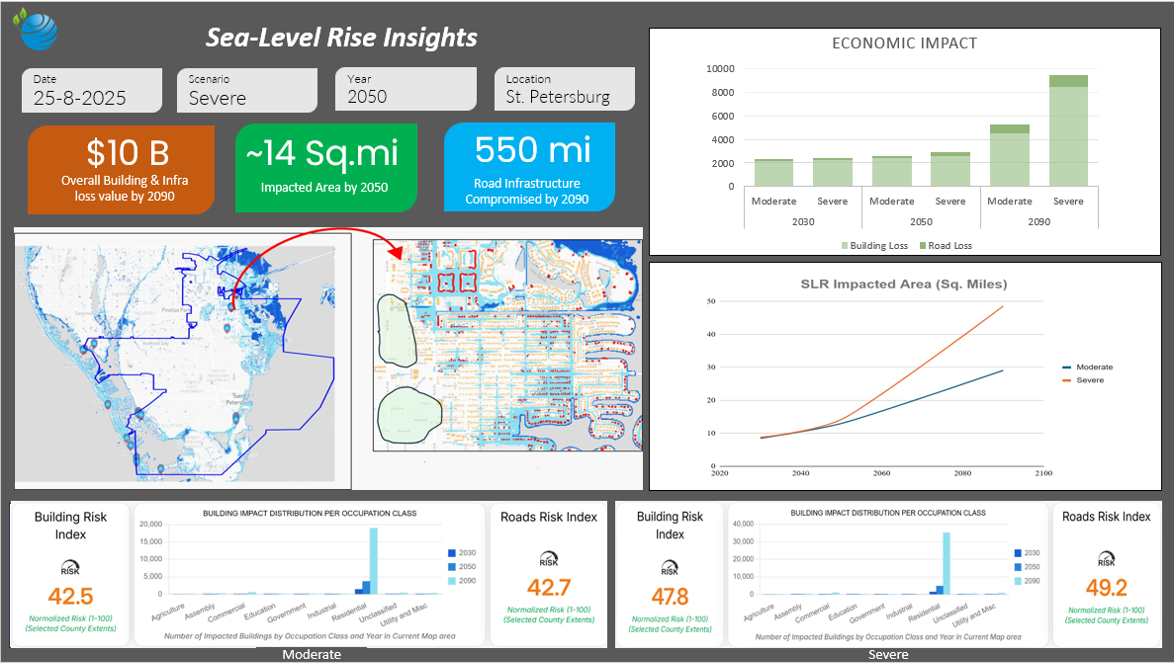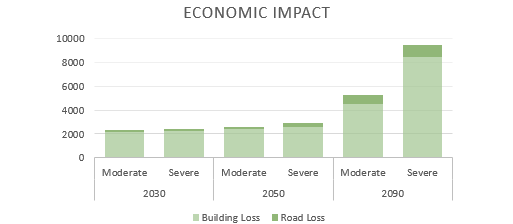
SLR Analytics for Future-Proofing Real Estate Development
Sep 5, 2025 @ 16:56
- by Vaishnavi KarlekarIntroduction: Florida’s Growth vs. Rising Seas
Florida continues to attract real estate investment, fueled by population growth, tourism, and development opportunities. But along with growth comes a sobering reality: sea-level rise (SLR) is reshaping the very ground on which these investments stand. For developers and real estate investors, the challenge is no longer whether to build, but where to build with confidence for the next 50–100 years.
Client Scenario: St. Petersburg Investment Zone
Our client, a real estate investment firm, exploring a large-scale project in a fast-growing Florida city St. Petersburg in Pinellas County, a mix of coastal and near-coastal zones.
The client’s key questions included:
- Identify safe parcels that can sustain development and maintain value for the next century.
- Understand direct property-level risks (inundated buildings, asset loss).
- Assess indirect infrastructure risks (road and access disruptions).
- Ensure that capital allocation avoids stranded assets and supports long-term resilience.
Traditional flood maps provided broad risk categories but failed to answer these questions with the precision required for multi-million-dollar development decisions.
Limitations of Traditional Approaches
- FEMA flood maps → too broad, static, and often outdated.
- Parcel blind spots → no differentiation between high-ground and low-lying parcels within the same flood zone.
- Infrastructure gap → do not consider indirect impacts such as flooded roads or utilities.
- Time horizons → fail to capture progressive risks across 2030, 2050, and 2090.
For investors, this means uncertainty and uncertainty translates to financial risk.
AssetRx Approach: Data-Driven Clarity
Using AssetRx’s SLR Insight Hub, we modeled both Intermediate (moderate) and Intermediate High (severe) scenarios across 2030, 2050, and 2090. The results revealed a layered story of rising exposure and shrinking safe zones:
- Buildings increasingly at risk: In 2030, around 1,600 structures face exposure, with losses near $2.2B. By 2090, this number balloons to over 35,000 buildings in the severe scenario — a near twentyfold increase.
- Infrastructure under strain: Early impacts are modest (~36–43 miles of roads by 2030). But by 2090, over 550 miles of roads — nearly 20% of the city’s total — could be compromised, disrupting access and services even for properties that remain dry.
- Cascading financial loss: Combined building and road loss values climb from $2–2.5B in 2030 to nearly $10B by 2090, underlining the compounding nature of direct and indirect impacts.
- Safe parcels identified: Despite these risks, our analysis pinpointed specific zones within St. Petersburg projected to remain SLR-free even under severe scenarios. These parcels represent resilient opportunities for long-term development.
- Community-level implications: Exposure isn’t isolated. As surrounding assets and infrastructure fail, unaffected parcels lose value — a systemic dynamic that only parcel-level + community analysis can capture.


How This Helped the Client
The client now had a century-long roadmap for investment planning:
- Avoiding zones with creeping inundation that would become stranded assets.
- Prioritizing SLR-resilient parcels where growth can safely continue.
- Understanding infrastructure dependencies that influence long-term usability.
- Demonstrating to stakeholders and investors that resilience is not an add-on but an embedded strategy.
Conclusion: Turning Risk into Resilient Returns
The St. Petersburg case underscores the new reality: growth without resilience is short-term growth. By combining climate scenarios, building-level exposure, and infrastructure analysis, AssetRx enabled the client to not just identify risk, but to see opportunity in the form of resilient parcels.
Lesson learned: Sea-level rise doesn’t have to derail development. With the right analytics, investors can channel growth into zones that will thrive well into the next century.
The lesson is clear: Sea-level rise doesn’t have to sink real estate value. With parcel-level insights, developers and investors can build on solid ground — literally and financially.